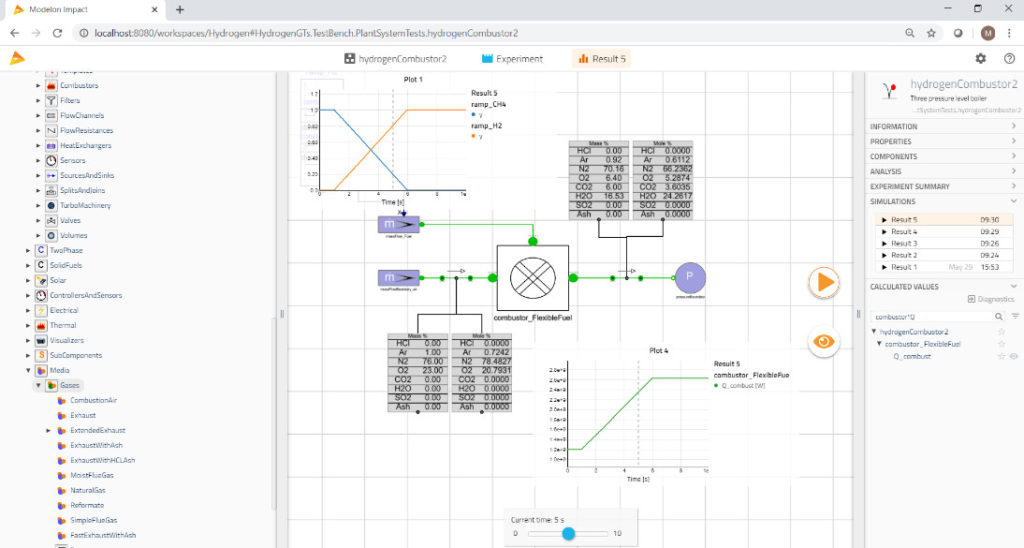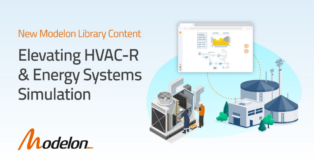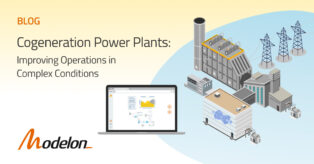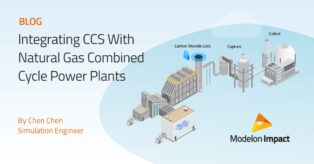Hydrogen Power: Integrating clean fuel to support a clean future
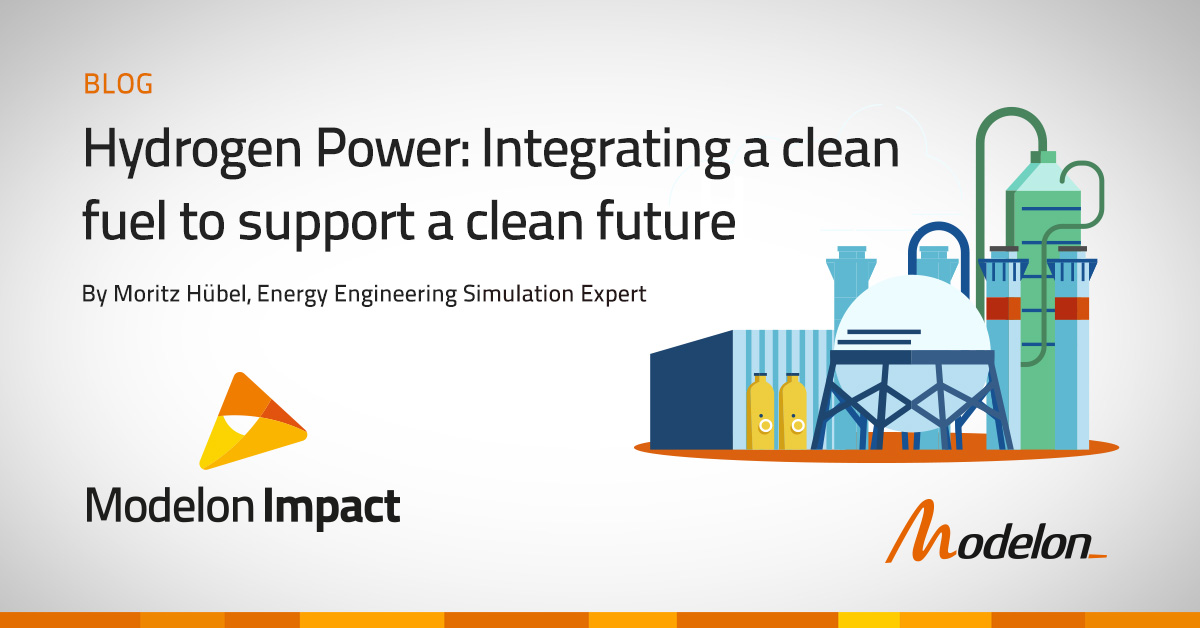
In this blog you will learn how to integrate hydrogen into an existing energy power system, using Modelon Impact
Replacing fossil fuels with hydrogen can be a significant step in integrating renewable energy in order to reduce CO2 emissions and mitigate climate change. In comparison to natural gas (consisting of hydrocarbon, mostly methane) the potential for cutting CO2 can be found by looking at the chemical reaction equations. Natural gas contains a high share of carbon therefore its combustion by-product will include CO2 emissions. In contrast, hydrogen gas (H2) does not produce any CO2 – its combustion with oxygen simply results in water (H2O).
To assist energy companies with reducing emissions power system component OEMs are developing burners that can handle more and more hydrogen gas. For example, Siemens more recently announced that they will increase the share of hydrogen in the very popular SGT-600 gas turbine series from 20% in 2020 to 100% in 2030. Using existing gas networks with an increased share of hydrogen gas, produced from renewable energy sources, is the sustainable solution for reducing emissions and diversifying energy systems.
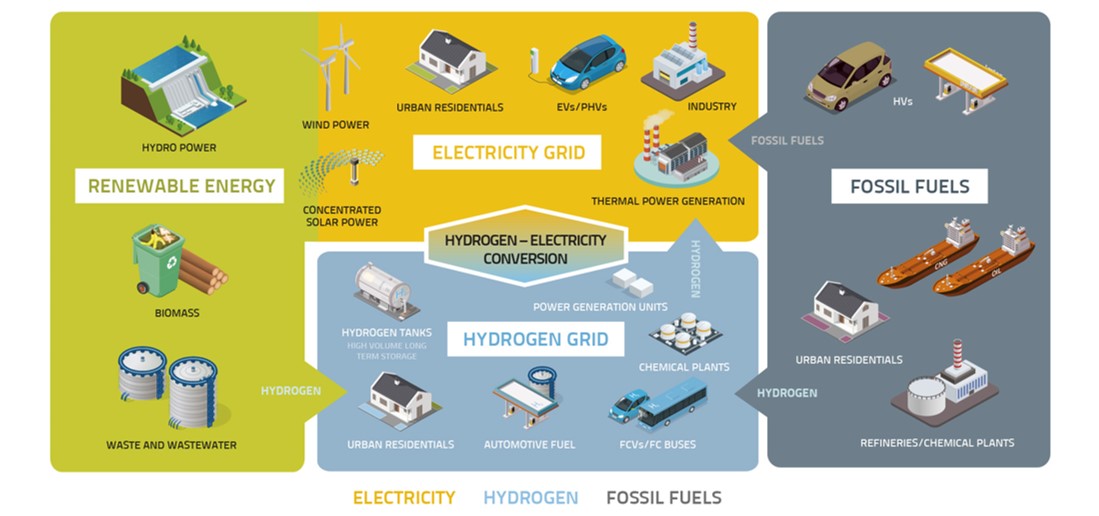
What is slowing energy companies from integrating hydrogen?
In many applications where natural gas can be replaced by hydrogen gas, energy companies need a component manufacturer to deliver a customized hydrogen capable burner or gas turbine that is optimized for the system at hand. However, incorporating new subsystems requires energy engineering teams to:
- Identify the best possible hydrogen fueled component(s)
- Make adaptations to an existing system that will be equipped with a new hydrogen fueled burner or that will be using an increased share of hydrogen gas in a conventional setup with natural gas
Hydrogen energy results in higher water content in the exhaust gas compared to natural gas. This results in a different heat capacity, which affects any subsequent heat exchangers and will lead to non-optimal operation when combined with an existing system without adaption. Additionally, the water content itself may become a problem if exhaust gas temperatures come below dew point temperature resulting in condensation of water and acids -leading to corrosion, increased maintenance costs and possible system failure.
Preparing power plants for hydrogen integration, using Modelon Impact
Utilizing Modelon Impact, Modelon’s web-based modeling platform, including Modelon’s Thermal Power Library, various combinations of fuel compositions can be simulated by basically just setting the value and pushing a button. Off-the-shelf media models for combustion and subsequent system simulation include not only methane and hydrogen gas but also a large variety of different components such as higher-order hydrocarbons and other combustible and inert gas components. The combustion component model includes mass and energy equations as well as the chemical reaction equations.
In addition, components for various applications such as heat exchangers, flow channels, turbomachinery are available and can be connected to and simulated within the graphical modelling canvas. Also predefined systems such as combined cycle power plant models are readily available.
Experimentation mode allows us to simulate large sets of input parameters such as the hydrogen content at different operation points.
Use-case: retrofitting existing combined cycle power plants
Natural gas plants are typically designed to operate for decades and are well integrated with other components such as heat recovery steam generators, for electricity generation as well as district heating. A typical use-case for the adaption would be the replacement of an existing natural gas fired gas turbine with a sustainable hydrogen gas fired turbine. Even if the gas turbine supplier could deliver a perfectly sized component with matching rated firing power, the same gas turbine in as well as outlet temperature, to replace an existing turbine in a combined cycle arrangement, there are still challenges for its integration. The subsequent recovery boiler would be exposed to the following changes:
- Exhaust Gas Composition – increased humidity and no carbon dioxide
- Heat Capacity – added water in flue gas per unit of mass is more than twice as high as the replaced carbon dioxide.
- Matching firing power and turbine inlet temperature – resulting in less combustion air and therefore lower exhaust flow rate.
By combining the flexible combustion component described above with a system model of a combined cycle power plant, the effects can be evaluated on any level.
Conclusion
With Modelon Impact, simulating the full plant model allows for the following conclusions to be made regarding the necessary adaptions for existing gas plants:
- If the gas turbine is designed in an ideal way, only small effects on the heat flow distribution in the heat recovery steam generator are expected. The increasing specific heat capacity of the water is compensating for the lower total flue gas flow. However, not well-suited gas turbines or duct burners can easily result in significant changes in the heat flow distribution and lead to less efficient and even dangerous operation.
- Increasing water content in the flue gas will in any case be an engineering challenge. Existing heat recovery systems are designed towards maximum efficiency and therefore low flue gas exit temperatures. Increasing humidity in the flue gas might lead to condensation and subsequent fouling and corrosion of heat exchangers.
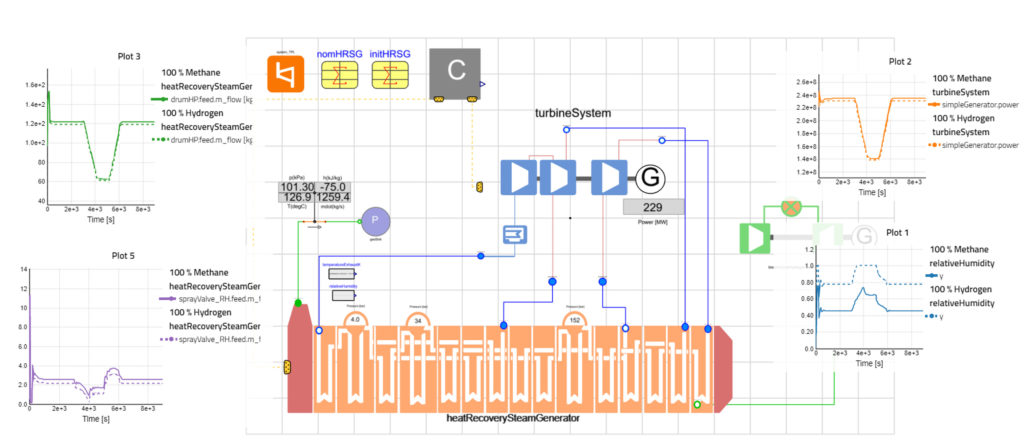
All the described technical challenges can be addressed in the design process of the hydrogen gas power plant or the retrofit of a hydrogen capable burners in existing energy systems using Modelon’s comprehensive simulation toolbox. In addition, Modelon Impact allows for a coupling of the dynamic models with live inputs and continuous simulation in order to monitor and evaluate existing energy systems for continuously safe and efficient operation.
